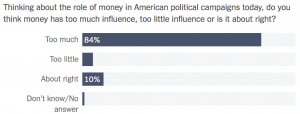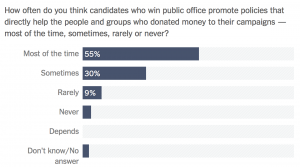Does the Design of the Supreme Court Put Our Democracy at Risk?
Chapter 14 in The Struggle for Democracy investigates whether or not the Supreme Court enhances American democracy. The framers designed the Supreme Court as an institution that would serve as a check on the other branches, particularly on Congress, which is the only semi-democratic institution in its design. The way the Supreme Court is set up and how it operates calls American democracy into question for a variety of reasons. First, the Supreme Court is structured to be the least democratic of the branches in the federal government because justices are appointed rather than elected, and serve for life instead of for a fixed term of office. Second, the Supreme Court has the power to override the decisions of presidents, Congress, and state legislatures, and make binding decisions for the nation as a whole. Third, Supreme Court justices never face the judgment of the voters. Lastly, a point the book doesn’t emphasize, is that the country’s campaign finance system needs significant changes. Overall, the way the Supreme Court currently operates does not protect democracy or individual rights and liberties and changes need to be made to ensure American democracy is healthy and representative of the population.
Who sits on the US Supreme Court matters to the health of our democracy. The Supreme Court is the ultimate power over and line of defense against the executive and legislative branches. Though the book outlines ways the Supreme Court has played a key role in protecting and expanding our democracy, the Campaign Legal Center explains that, “In the past two decades, we have seen the Court chip away at campaign finance and voting rights laws that are meant to preserve the right of every citizen to participate in our government.” The article goes on to explain that we can not leave the rules of our democracy to the wealthy and privileged elected officials. Instead, we must voice our public opinion to encourage the president to nominate a justice who understands that every eligible voter should be able to participate freely and have an equal say in our democracy. In the 2013 Shelby County v. Holder case, the “court dismantled a key provision of the VRA that allowed the Department of Justice or a three-judge federal court in DC to block discriminatory policies before they went into effect. Without the full protections of the VRA, we have seen an increase in state and local laws – from polling closures to strict voter ID laws to registration restrictions…” (Campaign Legal Center). For our most vulnerable populations, these changes make it much harder to vote, and this is an issue because the United States has a much lower voter turnout than other countries.
Furthermore, as we talked about in Chapter 10 about Participation, one of the causes of low voter turnout is because of the lack of party mobilization. Political parties do not want everybody to vote, they want their supporters to vote, so they keep certain citizens from voting and certain candidates off the ballot by changing Voter ID laws. The actual statistics on voting in presidential elections show that the participation shrinks from presidential elections, to midterm, to local elections. As participation shrinks, the disproportionately of voter demographics increases as voters become people with higher income and higher education. If those people have certain preferences, that’s who the government is going to listen to. Currently, there are no limits on the country’s campaign finance system, allowing wealthy elites to gain momentum and power through donations. Thus, the Court must discontinue the current path of changing Voter ID laws as in recent years and fill the seat with a justice who will protect voter rights and ultimately protect our democracy.
Initially, democracy was a right only white, property-owning males had – they were the only people who could vote or run for election, leaving the nation to be run by, and for, the few. This Truth-Out article explains that “Throughout history, people in the United States have worked together to fight for a true democracy – the participation and representation of all people in the political system.” However, not everyone has equal access to democracy. The Citizens United case allows people, corporations, and unions to donate unlimited amounts of money in politics, which limits our ability to provide equal representation and gives the elite, wealthy few more say in the political system than ordinary Americans. Ultimately, this prevents anyone not wealthy enough to compete in money-based politics from having full access to democracy in the US.
A NYTimes poll reveals that the public thinks the country’s campaign finance system needs significant changes.
The polls show that an overwhelming amount of Americans feel there should be a limit on the amount of money that can be contributed to political campaigns. In the last question, the results show that 85% of the population believe those candidates that use unjust methods to ensure they are elected will help only the people who donated to their campaigns through public policies. This relates back to the idea of participation and low voter turnout because of party mobilization. If candidates are changing Voter ID laws through the Supreme Court to restrict certain citizens from voting, the majority of the population is likely not represented, meaning our popular sovereignty is being violated, and our country does not have a healthy, representative democracy.
Ultimately, it’s time for there to be changes made to the Supreme Court. First, there shouldn’t just be wealthy people controlling it – we need more representation since that is what our country’s democracy is founded on and our nation is moving towards more diversity. Second, there needs to be a change to the country’s campaign finance system to ensure all citizens are able to run for office. Lastly, Supreme Court justices should serve for a fixed term and have a mandatory retirement age instead of serving their whole life. This Washington Post article suggests one way the term could be fixed: “Norm Ornstein likes the idea of an 18-year term limit, saying it would ‘lower the temperature on confirmation battles by making the stakes a bit lower. And it would mean a Court that more accurately reflects the changes and judgments of the society.’” As the book explains, if federal judges are isolated from popular influence, democracy is at risk. Thus, if a federal judge is old, with outdated beliefs and has had limited adjustment to new practices and technological advances, the Supreme Court may not make the most thoughtful, beneficial decisions. Thus, there should be a change to the term of federal judges.
These are just a few of the ways the Supreme Court needs to be changed to promote a healthy, representative democracy. Do you agree that changes should be made to the Supreme Court? Are there other changes you think are more important than the ones I proposed?


